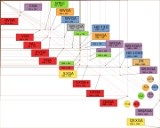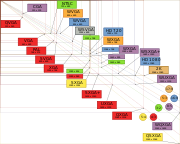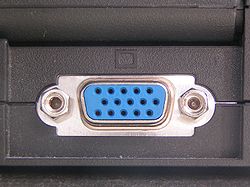
Super Video Graphics Array
Encyclopedia
Super Video Graphics Array or Ultra Video Graphics Array, almost always abbreviated to Super VGA, Ultra VGA or just SVGA or UVGA is a broad term that covers a wide range of computer display standard
s.

 Originally, it was an extension to the VGA
Originally, it was an extension to the VGA
standard first released by IBM
in 1987. Unlike VGA—a purely IBM-defined standard—Super VGA was never formally defined. The closest to an "official" definition was in the VBE
extensions defined by the Video Electronics Standards Association (VESA), an open consortium set up to promote interoperability and define standards. In this document, there was simply a footnote stating that "The term 'Super VGA' is used in this document for a graphics display controller implementing any superset of the standard IBM VGA display adapter." When used as a resolution specification, in contrast to VGA or XGA for example, the term SVGA normally refers to a resolution of 800 × 600 pixels.
Though Super VGA cards appeared in the same year as VGA (1987), it wasn't until 1989 that a standard for programming Super VGA modes was defined by VESA. In that first version, it defined support for (but did not require) a maximum resolution of 800 × 600 4-bit pixels. Each pixel could therefore be any of 16 different colours. It was quickly extended to 1024 × 768 8-bit pixels, and well beyond that in the following years.
Although the number of colours is defined in the VBE specification, this is irrelevant when referring to Super VGA monitors as (in contrast to the old CGA
and EGA
standards) the interface between the video card and the VGA or Super VGA monitor uses simple analog voltages to indicate the desired colour. In consequence, so far as the monitor is concerned, there is no theoretical limit to the number of different colours that can be displayed. Note that this applies to any VGA or Super VGA monitor.
While the output of a VGA or Super VGA video card is analog, the internal calculations the card performs in order to arrive at these output voltages are entirely digital. To increase the number of colours a Super VGA display system can reproduce, no change at all is needed for the monitor, but the video card needs to handle much larger numbers and may well need to be redesigned from scratch. Even so, the leading graphics chip vendors were producing parts for high-colour
video cards within just a few months of Super VGA's introduction.
On paper, the original Super VGA was to be succeeded by Super XGA, but in practice the industry soon abandoned the attempt to provide a unique name for each higher display standard, and almost all display systems made between the late 1990s and the early 2000s are classed as Super VGA.
Monitor manufacturers sometimes advertise their products as XGA or Super XGA. In practice this means little, since all Super VGA monitors manufactured since the later 1990s have been capable of at least XGA and usually considerably higher performance.
SVGA uses a VGA connector
, the same DE-15 (a.k.a. HD-15) as the original standard.
See also Digital Visual Interface
which is a common non-analog cable for SVGA and other resolutions.
Computer display standard
Computer display standards are often a combination of aspect ratio, display resolution, color depth, and refresh rate.This article describes the different display standards for computer displays.-History:...
s.


Video Graphics Array
Video Graphics Array refers specifically to the display hardware first introduced with the IBM PS/2 line of computers in 1987, but through its widespread adoption has also come to mean either an analog computer display standard, the 15-pin D-subminiature VGA connector or the 640×480 resolution...
standard first released by IBM
IBM
International Business Machines Corporation or IBM is an American multinational technology and consulting corporation headquartered in Armonk, New York, United States. IBM manufactures and sells computer hardware and software, and it offers infrastructure, hosting and consulting services in areas...
in 1987. Unlike VGA—a purely IBM-defined standard—Super VGA was never formally defined. The closest to an "official" definition was in the VBE
VESA BIOS Extensions
VESA BIOS Extensions is a VESA standard, currently at version 3, that defines the interface that can be used by software to access compliant video boards at high resolutions and bit depths...
extensions defined by the Video Electronics Standards Association (VESA), an open consortium set up to promote interoperability and define standards. In this document, there was simply a footnote stating that "The term 'Super VGA' is used in this document for a graphics display controller implementing any superset of the standard IBM VGA display adapter." When used as a resolution specification, in contrast to VGA or XGA for example, the term SVGA normally refers to a resolution of 800 × 600 pixels.
Though Super VGA cards appeared in the same year as VGA (1987), it wasn't until 1989 that a standard for programming Super VGA modes was defined by VESA. In that first version, it defined support for (but did not require) a maximum resolution of 800 × 600 4-bit pixels. Each pixel could therefore be any of 16 different colours. It was quickly extended to 1024 × 768 8-bit pixels, and well beyond that in the following years.
Although the number of colours is defined in the VBE specification, this is irrelevant when referring to Super VGA monitors as (in contrast to the old CGA
Color Graphics Adapter
The Color Graphics Adapter , originally also called the Color/Graphics Adapter or IBM Color/Graphics Monitor Adapter, introduced in 1981, was IBM's first color graphics card, and the first color computer display standard for the IBM PC....
and EGA
Enhanced Graphics Adapter
The Enhanced Graphics Adapter is the IBM PC computer display standard specification which is between CGA and VGA in terms of color and space resolution. Introduced in October 1984 by IBM shortly after its new PC/AT, EGA produces a display of 16 simultaneous colors from a palette of 64 at a...
standards) the interface between the video card and the VGA or Super VGA monitor uses simple analog voltages to indicate the desired colour. In consequence, so far as the monitor is concerned, there is no theoretical limit to the number of different colours that can be displayed. Note that this applies to any VGA or Super VGA monitor.
While the output of a VGA or Super VGA video card is analog, the internal calculations the card performs in order to arrive at these output voltages are entirely digital. To increase the number of colours a Super VGA display system can reproduce, no change at all is needed for the monitor, but the video card needs to handle much larger numbers and may well need to be redesigned from scratch. Even so, the leading graphics chip vendors were producing parts for high-colour
Highcolour
High color graphics is a method of storing image information in a computer's memory such that each pixel is represented by two bytes...
video cards within just a few months of Super VGA's introduction.
On paper, the original Super VGA was to be succeeded by Super XGA, but in practice the industry soon abandoned the attempt to provide a unique name for each higher display standard, and almost all display systems made between the late 1990s and the early 2000s are classed as Super VGA.
Monitor manufacturers sometimes advertise their products as XGA or Super XGA. In practice this means little, since all Super VGA monitors manufactured since the later 1990s have been capable of at least XGA and usually considerably higher performance.
SVGA uses a VGA connector
VGA connector
A Video Graphics Array connector is a three-row 15-pin DE-15 connector. The 15-pin VGA connector is found on many video cards, computer monitors, and some high definition television sets...
, the same DE-15 (a.k.a. HD-15) as the original standard.
See also Digital Visual Interface
Digital Visual Interface
The Digital Visual Interface is a video interface standard covering the transmission of video between a source device and a display device. The DVI standard has achieved widespread acceptance in the PC industry, both in desktop PCs and monitors...
which is a common non-analog cable for SVGA and other resolutions.
First manufacturers
Some of the early SuperVGA manufacturers (in parentheses, some of their models, where available) were:- Ahead Technologies Not related with Nero AGNero AGNero is a global computer software company headquartered in Karlsbad, Germany. It is perhaps most well-known for its burning software, Nero Burning ROM.-History:The company was founded as Ahead Software GmbH in 1995 by Richard Lesser....
(formerly Ahead Software) - Amdek (VGA ADAPTER/132)
- AST Research, Inc. (VGA Plus (rebranded Paradise))
- ATI TechnologiesATI TechnologiesATI Technologies Inc. was a semiconductor technology corporation based in Markham, Ontario, Canada, that specialized in the development of graphics processing units and chipsets. Founded in 1985 as Array Technologies Inc., the company was listed publicly in 1993 and was acquired by Advanced Micro...
(VIP (82c441 (1987)), VGA Wonder) - Chips and TechnologiesChips and TechnologiesChips and Technologies was the first fabless semiconductor company, a model developed by its founder Gordon Campbell. Founded by Dado Banatao.Its first product was an EGA IBM compatible graphics chip...
(82c441 (1987)) - Cirrus LogicCirrus LogicCirrus Logic is a fabless semiconductor supplier specializing in analog, mixed-signal, and audio DSP integrated circuits . They are presently headquartered in Austin, Texas. Their audio processors and audio converters are found in many professional audio and consumer entertainment products,...
(CL-GD410/420 (1987)) - CompaqCompaqCompaq Computer Corporation is a personal computer company founded in 1982. Once the largest supplier of personal computing systems in the world, Compaq existed as an independent corporation until 2002, when it was acquired for US$25 billion by Hewlett-Packard....
(VGC Board) - EverexEverexEverex is a manufacturer of desktop and notebook personal computers. It was established in 1983 and headquartered in Fremont, California. The company was founded by Steve Hui, John Lee and Wayne Cheung. In 1988, Everex was the leader in tape backup sales with half the world market...
- Genoa Inc. (Genoa VGA 5100-5400 (ET3000))
- Orchid TechnologyOrchid TechnologyOrchid Technology was a privately held company founded by Le Nhon Bui in 1982. The company's original flagship product was its PCNet card, a 1 megabit-per-second LAN card for IBM PCs and clones. Notably, the acronym LAN is the Vietnamese word for "Orchid"...
(Designer VGA (ET3000), Pro Designer Plus) - Paradise Inc. (VGA Plus (PVGA1A (1987)), VGA Plus 16, VGA Pro)
- Sigma DesignsSigma DesignsSigma Designs is an American public corporation that designs and builds high-performance system-on-a-chip semiconductor technologies for Internet-based set-top boxes, DVD players/recorders, high-definition televisions, media processors, digital media adapters, portable media players and home...
(SigmaVGA (ET3000)) - STB Technologies (VGA Extra/EM (ET3000 (1987)))
- TecmarTecmarTecmar was an American manufacturer of PC enhancement products based in Solon, OH. The company was founded in 1974 and their first products were data acquisition boards for the first generation of microcomputers. Popular products included the Scientific Solutions LabMaster series of boards for...
(Tecmar VGA (ET3000), VGA AD) - Trident MicrosystemsTrident MicrosystemsTrident Microsystems is a supplier of display-processors for flat panel displays . At one time, Trident was also a supplier of PC graphics chipsets and sound controllers.- History :...
(8800, 8900) - Tseng LabsTseng LabsTseng Laboratories, Inc. was a maker of graphics chips and controllers for IBM PC compatibles, based in Newtown, Pennsylvania, and founded by Jack H-N Tseng....
(ET3000 (1987), ET4000) - Video 7 (VEGA VGA (CL-GD410/420 (1987)), FastWrite (1988), V-RAM VGA (1988))
- Willow (VGA-TV/Publisher's, VGA-TV + Genlock)

